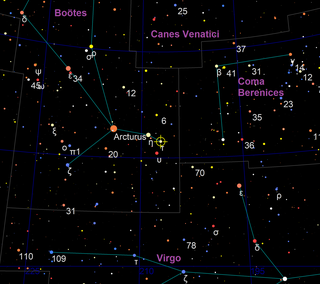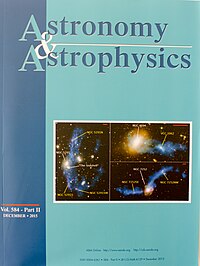
Tau Boötis, Latinised from τ Boötis, is an F-type main-sequence star approximately 51 light-years away in the constellation of Boötes. It is a binary star system, with the secondary star being a red dwarf. In 1999, an extrasolar planet was detected orbiting the primary star. In December 2020, astronomers may have observed, for the first time, radio emissions from a planet beyond the Solar System. According to the researchers: "The signal is from the Tau Boötis system, which contains a binary star and an exoplanet. We make the case for an emission by the planet itself."
N Centauri is a binary star in the southern constellation of Centaurus. The brighter star is dimly visible to the naked eye with an apparent visual magnitude of 5.26, and it is approximately 304 light years away based on parallax. It has an absolute magnitude of +0.76 and is drifting further away from the Sun with a radial velocity of +27 km/s. It is a candidate member of the Sco OB2 moving group.

R Boötis is a variable star in the northern constellation of Boötes. Typically the star is too faint to be readily visible to the naked eye, with a brightness that fluctuates between apparent visual magnitudes of 9.98. The distance to this star is approximately 2,150 light years based on parallax measurements. It is drifting closer with a radial velocity of about −58 km/s.
HD 190984, also known as HIP 99496, is a star located in the southern circumpolar constellation Pavo, the peacock. It has an apparent magnitude of 8.76, making it readily visible in small telescopes, but not to the naked eye. Based on parallax measurements from the Gaia spacecraft, the object is estimated to be 486 light years away from the Solar System. It appears to be receding with a heliocentric radial velocity of 20.3 km/s.

HD 24479, also designated as HR 1204, is a solitary, bluish-white hued star located in the northern circumpolar constellation Camelopardalis. The star is visible to the naked eye with an apparent visual magnitude of 5.04. Based on Gaia DR3 parallax measurements, it is located 385 light years from the Sun. However, it is receding with a somewhat constrained heliocentric radial velocity of 4.6 km/s. At its current distance, HD 24479's brightness is diminished by 0.29 magnitudes due to interstellar dust.
HD 191806 is a star located in the northern constellation Cygnus. With an apparent magnitude of 8.093, it's undetectable with the naked eye, but can be seen with binoculars. HD 191806 is currently placed at a distance of 215 light years based on parallax measurements and is drifting towards the Solar System with a spectroscopic radial velocity of −15.28 km/s.

Georges Meylan is a Swiss astronomer, born on July 31, 1950, in Lausanne, Switzerland. He was the director of the Laboratory of Astrophysics of the Swiss Federal Institute of Technology (EPFL) in Lausanne, Switzerland, and now a professor emeritus of astrophysics and cosmology at EPFL. He is still active in both research and teaching.

DS Tucanae is a binary star system 144 light years away in the constellation of Tucana. It has an apparent visual magnitude of 8.5, and is a RS Canum Venaticorum variable. The system is notable for being young as a member of the 45 Myr old Tucana-Horologium moving group and for the primary star hosting the confirmed exoplanet DS Tucanae Ab, discovered by THYME, using TESS.

HD 26764, also known as HR 1314 or rarely 14 H. Camelopardalis, is a solitary white hued star located in the northern circumpolar constellation Camelopardalis. It has an apparent magnitude of 5.19, making it faintly to the naked eye if viewed under good conditions. Gaia DR3 parallax measurements place the object at a distance of 266 light years and is drifting closer with a poorly constrained heliocentric radial velocity of 3 km/s. At its current distance, HD 26764's brightness is diminished by 0.26 magnitudes due to interstellar dust.
HD 212771, also named Lionrock, is a solitary star in the southern zodiac constellation Aquarius. It has an apparent magnitude of 7.60, making it readily visible with binoculars but not the naked eye. Parallax measurements place the object at a distance of 364 light years, and is currently receding with a radial velocity of 15 km/s.
HD 46588 is a star in the northern circumpolar constellation Camelopardalis. It has an apparent magnitude of 5.44, allowing it to be faintly seen with the naked eye. The object is relatively close at a distance of only 59 light years but is receding with a heliocentric radial velocity of 15 km/s.
13 Delphini is a binary star in the equatorial constellation Delphinus, with a combined apparent magnitude of 5.64. The system is located at a distance of 471 light years but is approaching the Solar System with a heliocentric radial velocity of about −7 km/s.

Xi Octantis, Latinized from ξ Octantis, is a solitary variable star in the southern circumpolar constellation Octans. It has an apparent magnitude of about 5.3, allowing it to be faintly seen with the naked eye; however, this varies slightly. Located 514 light years away, the object is receding with a heliocentric radial velocity of 22 km/s.
HD 33519, also known as HR 1682, is a probable spectroscopic binary located in the southern circumpolar constellation Mensa. It is one of the stars near the limit of naked eye visibility, having an apparent magnitude of 6.28. The system is relatively far at a distance of 940 light years but is approaching with a heliocentric radial velocity of −2.5 km/s. However, this value is poorly constrained.

CW Octantis, also known as HD 148542, is a solitary, white hued variable star located in the southern circumpolar constellation Octans. It has an apparent magnitude of 6.03, allowing it to be faintly visible to the naked eye. Parallax measurements from Gaia DR3 place the object at a distance of 629 light years. It appears to be receding from the Solar System with a heliocentric radial velocity of 7.1 km/s.

40 Leonis Minoris is a white hued star located in the northern constellation Leo Minor. It is rarely called 14 H. Leonis Minoris, which is the designation given by Polis astronomer Johann Hevelius.









